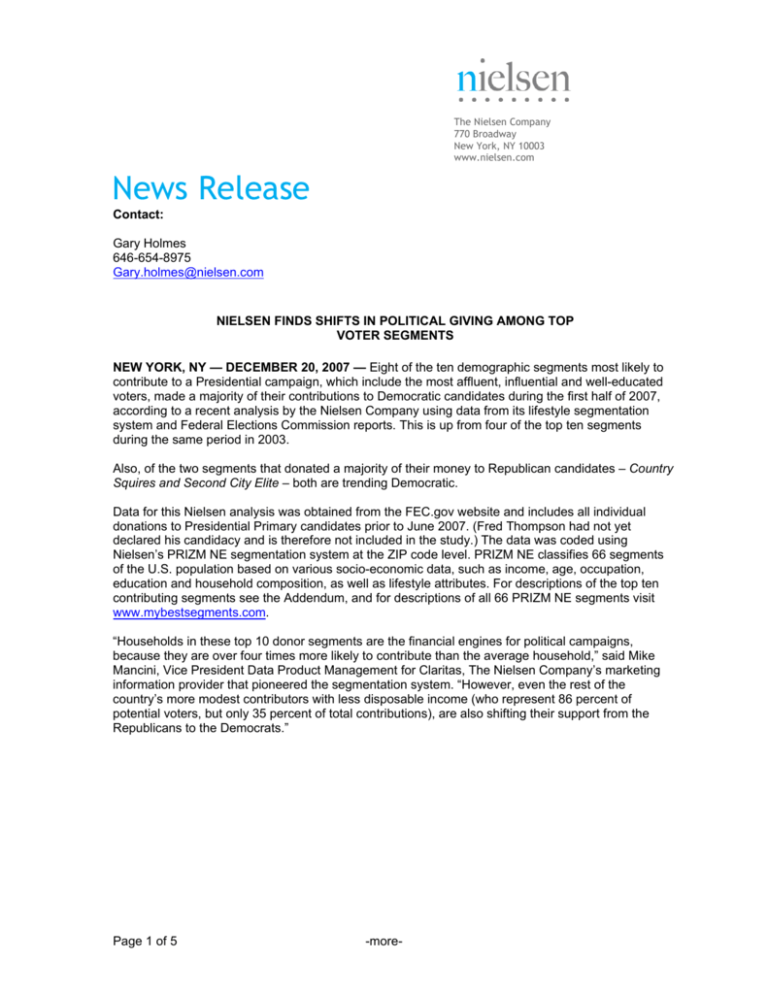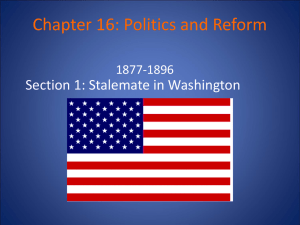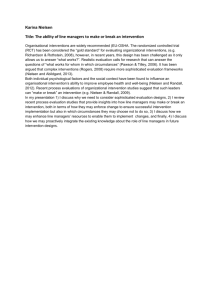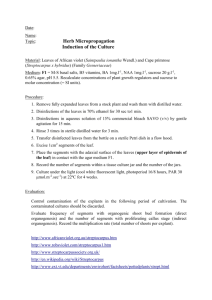News Release
advertisement

The Nielsen Company 770 Broadway New York, NY 10003 www.nielsen.com News Release Contact: Gary Holmes 646-654-8975 Gary.holmes@nielsen.com NIELSEN FINDS SHIFTS IN POLITICAL GIVING AMONG TOP VOTER SEGMENTS NEW YORK, NY — DECEMBER 20, 2007 — Eight of the ten demographic segments most likely to contribute to a Presidential campaign, which include the most affluent, influential and well-educated voters, made a majority of their contributions to Democratic candidates during the first half of 2007, according to a recent analysis by the Nielsen Company using data from its lifestyle segmentation system and Federal Elections Commission reports. This is up from four of the top ten segments during the same period in 2003. Also, of the two segments that donated a majority of their money to Republican candidates – Country Squires and Second City Elite – both are trending Democratic. Data for this Nielsen analysis was obtained from the FEC.gov website and includes all individual donations to Presidential Primary candidates prior to June 2007. (Fred Thompson had not yet declared his candidacy and is therefore not included in the study.) The data was coded using Nielsen’s PRIZM NE segmentation system at the ZIP code level. PRIZM NE classifies 66 segments of the U.S. population based on various socio-economic data, such as income, age, occupation, education and household composition, as well as lifestyle attributes. For descriptions of the top ten contributing segments see the Addendum, and for descriptions of all 66 PRIZM NE segments visit www.mybestsegments.com. “Households in these top 10 donor segments are the financial engines for political campaigns, because they are over four times more likely to contribute than the average household,” said Mike Mancini, Vice President Data Product Management for Claritas, The Nielsen Company’s marketing information provider that pioneered the segmentation system. “However, even the rest of the country’s more modest contributors with less disposable income (who represent 86 percent of potential voters, but only 35 percent of total contributions), are also shifting their support from the Republicans to the Democrats.” Page 1 of 5 -more- Top 10 Segments for Donation Trends – 2004 to 2008 2008 Total Donated $ Segment Nickname 2004 % of Donations % point Change to Democrat 2008 % of Donations (in Millions) GOP Dem GOP Dem ‘04 to ‘08 Increase for Democrats $31.1 35.6% 64.4% 28.8% 71.2% 6.8% $30.7 52.2% 47.8% 41.7% 58.3% 10.5% $21.2 32.2% 67.8% 31.0% 69.0% 1.2% $12.9 32.6% 67.% 26.8% 73.2% 6.2% $12.0 61.7% 38.3% 47.2% 52.8% 14.5% $10.7 55.0% 45.0% 47.3% 52.7% 7.7% $8.4 54.9% 45.1% 47.5% 52.5% 7.4% $7.2 60.2% 39.8% 53.2% 46.8% 7.0% $6.4 40.5% 59.5% 28.9% 71.1% 11.6% $4.8 $145.4 54.5% 46.6% 45.5% 53.4% 51.1% 40.1% 48.9% 59.9% 3.4% 6.5% Young Digerati Upper Crust (Shifted to Dem) Money & Brains Bohemian Mix Movers & Shakers (Shifted to Dem) Big Fish, Small Pond (Shifted to Dem) Blue Blood Estates (Shifted to Dem) Country Squires (Trending to Dem) Urban Achievers Second City Elite (Trending to Dem) Total The study showed that 64 percent of the donors in the top 10 donor segments gave to Democratic candidates compared to 36 percent for Republican candidates. The numbers were also similar for donations, with Democratic candidates receiving 62 percent of the donated dollars and Republicans receiving 38 percent. Nationally, Democrats are out-raising Republicans, capturing nearly 60 percent of all donated dollars. This capture rate is even more acute in urban segments where Democrats average closer to 70 percent across most segments. Suburbia is more varied, from a high near 70 percent to a low of 38 percent, but an overall average capture rate of 55 percent for Democrats. Percentage of Donated Dollars by Segment Group 2008 Dem 2008 GOP Urban 69.9% 30.1% Suburban 54.7% 45.3% Second City (Satellite Cities) 54.1% 45.9% Town & Country (Rural) 50.2% 49.8% Total 59.9% 40.1% -more- Page 2 of 5 In addition, the rural heartland and small town America has lost its strong tilt towards Republican contributions of years past with Democratic and Republican candidates now obtaining about a 50/50 split across the group’s segments. The upper and middle-class of rural America still lean more Republican—in terms of donors and dollars given—while the lower income segments favor Democratic candidates. Although the percentage split between the number of Republican and Democratic donors has remained relatively flat since the last election, dollar donations for 2008 has tilted towards the Democratic side. In key segments like Movers & Shakers, Urban Achievers, and Upper Crust, there are double digit increases in funding from the Republicans in 2004 to the Democrats in 2008. In terms of frontrunner candidates, the analysis revealed the following: • Rudy Giuliani received 14 percent of all donations (35 percent of donations to Republicans). He is attracting more support from urban and metro areas and looks to do better with a mix of both liberal and conservative segments including Close-in Couples (17 percent overall; 53 percent share of donors among Republicans), Cosmopolitans (15 percent overall; 48 percent of Republicans), and Second City Elite (20 percent overall; 39 percent of Republicans). • Mitt Romney received 14 percent of all donations (36 percent of donations to Republicans). He has success in suburban areas with more traditional lifestyle segments that include Domestic Duos (35 percent overall; 62 percent of Republicans), Kids & Cul-de-Sacs (30 percent overall, 58 percent of Republicans) and White Picket Fences (34 percent overall, 56 percent of Republicans). • Hillary Clinton received 21 percent of all donations (35 percent of donations to Democrats). She draws contributors from Family Life segments, including Suburban Pioneers (48 percent overall; and 68 percent of Democrats), Low-Rise Living (34 percent overall; 51 percent of Democrats), Beltway Boomers (22 percent overall; and 46 percent of Democrats), which are households with a high percentage of children. • Barak Obama received 20 percent of all donations (33 percent of donations to Democrats). He does well with a number of blue-collar and mid-scale segments including Blue-Chip Blues (24 percent overall; 45 percent of Democrats), City Roots (28 percent overall; 40 percent of Democrats) as well as younger segments like Bohemian Mix and Urban Achievers (approximately 29 percent overall; 39 percent of Democrats, each) and Young Digerati (26 percent overall; 37 percent of Democrats). About The Nielsen Company The Nielsen Company is a global information and media company with leading market positions and recognized brands in marketing information (ACNielsen), media information (Nielsen Media Research), online intelligence (Nielsen Online), mobile media (Nielsen Mobile), trade shows and business publications (Billboard, The Hollywood Reporter, Adweek). The privately held company is active in more than 100 countries, with headquarters in Haarlem, the Netherlands, and New York, USA. Claritas is the pre-eminent source of accurate, up-to-date marketing information about people, households and businesses within any geographic area in the United States. It offers industry-leading consumer segmentation systems, consulting services and marketing software applications for site location analysis, advertising sales and client targeting. For more information please visit: www.nielsen.com or www.claritas.com. ##### Page 3 of 5 Addendum Descriptions of Top 10 Voter Segments: Young Digerati - Young Digerati are the nation's tech-savvy singles and couples living in fashionable neighborhoods on the urban fringe. Affluent, highly educated and ethnically mixed, Young Digerati communities are typically filled with trendy apartments and condos, fitness clubs and clothing boutiques, casual restaurants and all types of bars--from juice to coffee to microbrew. Upper Crust - The nation's most exclusive address, Upper Crust is the wealthiest lifestyle in America--a haven for empty-nesting couples over 55 years old. No segment has a higher concentration of residents earning over $200,000 a year or possessing a postgraduate degree. And none has a more opulent standard of living. Money & Brains - The residents of Money & Brains seem to have it all: high incomes, advanced degrees and sophisticated tastes to match their credentials. Many of these city dwellers-predominantly white with a high concentration of Asian Americans--are married couples with few children who live in fashionable homes on small, manicured lots. Bohemian Mix - A collection of young, mobile urbanites, Bohemian Mix represents the nation's most liberal lifestyles. Its residents are a progressive mix of young singles and couples, students and professionals, Hispanics, Asians, African-Americans and whites. In their funky rowhouses and apartments, Bohemian Mixers are the early adopters who are quick to check out the latest movie, nightclub, laptop and microbrew. Movers & Shakers - Movers & Shakers is home to America's up-and-coming business class: a wealthy suburban world of dual-income couples who are highly educated, typically between the ages of 35 and 54, often without children. Given its high percentage of executives and white-collar professionals, there's a decided business bent to this segment: Movers & Shakers rank number-one for owning a small business and having a home office. Big Fish, Small Pond - Older, upper-class, college-educated professionals, the members of Big Fish, Small Pond are often among the leading citizens of their small-town communities. These upscale, empty-nesting couples enjoy the trappings of success, belonging to country clubs, maintaining large investment portfolios and spending freely on computer technology. Blue Blood Estates - Blue Blood Estates is a family portrait of suburban wealth, a place of milliondollar homes and manicured lawns, high-end cars and exclusive private clubs. The nation's secondwealthiest lifestyle, it is characterized by married couples with children, college degrees, a significant percentage of Asian Americans and six-figure incomes earned by business executives, managers and professionals. Country Squires - The wealthiest residents in exurban America live in Country Squires, an oasis for affluent Baby Boomers who've fled the city for the charms of small-town living. In their bucolic communities noted for their recently built homes on sprawling properties, the families of executives live in six-figure comfort. Country Squires enjoy country club sports like golf, tennis and swimming as well as skiing, boating and biking. Urban Achievers - Concentrated in the nation's port cities, Urban Achievers is often the first stop for up-and-coming immigrants from Asia, South America and Europe. These young singles and couples are typically college-educated and ethnically diverse: about a third are foreign-born, and even more speak a language other than English. Page 4 of 5 Second City Elite - There's money to be found in the nation's smaller cities, and you're most likely to find it in Second City Elite. The residents of these satellite cities tend to be prosperous executives who decorate their $200,000 homes with multiple computers, large-screen TV sets and an impressive collection of wines. With more than half holding college degrees, Second City Elite residents enjoy cultural activities--from reading books to attending theater and dance productions. Page 5 of 5








